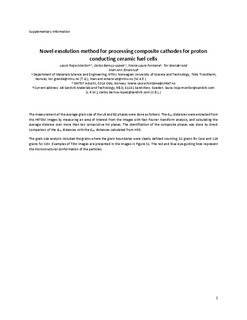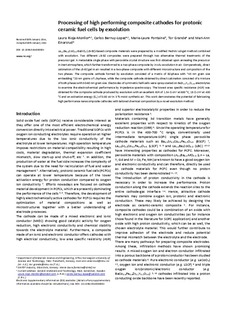| dc.contributor.author | Rioja-Monllor, Laura | |
| dc.contributor.author | Bernuy-Lopez, Carlos | |
| dc.contributor.author | Fontaine, Marie-Laure | |
| dc.contributor.author | Grande, Tor | |
| dc.contributor.author | Einarsrud, Mari-Ann | |
| dc.date.accessioned | 2019-03-22T09:25:30Z | |
| dc.date.available | 2019-03-22T09:25:30Z | |
| dc.date.created | 2019-03-20T10:40:15Z | |
| dc.date.issued | 2019 | |
| dc.identifier.issn | 2050-7488 | |
| dc.identifier.uri | http://hdl.handle.net/11250/2591242 | |
| dc.description.abstract | La0.5Ba0.5CoO3-δ-BaZrO3 (LB-BZ)-based composite materials were prepared by a modified Pechini sol-gel method combined with exsolution. Two different LB-BZ composites were prepared through two alternative thermal treatments of the precursor gel. A metastable single phase with perovskite crystal structure was first obtained upon annealing the precursor in inert atmosphere, which further transformed to a two-phase composite by in situ exsolution in air. Comparetively, direct calcination of the LB-BZ gel in air resulted in a two-phase composite with different microstructure and composition of the two phases. The composite cathode formed by exsolution consisted of a matrix of BZ-phase with ~45 nm grain size embedding ~20 nm grains of LB-phase, while the composite cathode obtained by direct calcination consisted of a mixture of both phases with 50-60 nm grain size. Electrodes of symmetric half-cells were spray-coated on BaZr0.9Y0.1O2.95 electrolytes to examine the electrochemical performance by impedance spectroscopy. The lowest area specific resistance (ASR) was obtained for the composite cathode produced by exsolution with an excellent ASR of 1.54 Ω cm2 at 600 °C, 18 Ω cm2 at 400 °C and an activation energy (Ea) of 0.60 eV in 3 % moist synthetic air. This work demonstrates the potential of fabricating high performance nanocomposite cathodes with tailored chemical composition by a novel exsolution method. | nb_NO |
| dc.language.iso | eng | nb_NO |
| dc.publisher | Royal Society of Chemistry | nb_NO |
| dc.title | Processing of high performing composite cathodes for protonic ceramic fuel cells by exsolution | nb_NO |
| dc.type | Journal article | nb_NO |
| dc.type | Peer reviewed | nb_NO |
| dc.description.version | acceptedVersion | nb_NO |
| dc.source.journal | Journal of Materials Chemistry A | nb_NO |
| dc.identifier.doi | 10.1039/C8TA10950H | |
| dc.identifier.cristin | 1686222 | |
| dc.relation.project | Norges forskningsråd: 228355 | nb_NO |
| dc.description.localcode | © 2019. This is the authors' accepted and refereed manuscript to the article. Locked until 11.3.2020 due to copyright restrictions. The final authenticated version is available online at: http://dx.doi.org/10.1039/C8TA10950H | nb_NO |
| cristin.unitcode | 194,66,35,0 | |
| cristin.unitname | Institutt for materialteknologi | |
| cristin.ispublished | true | |
| cristin.fulltext | postprint | |
| cristin.qualitycode | 1 | |

